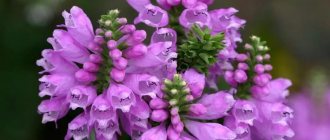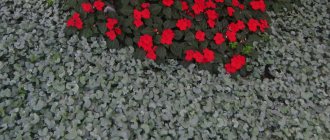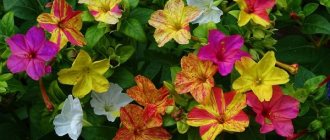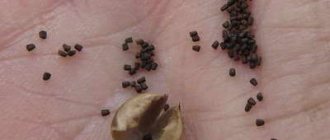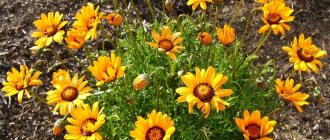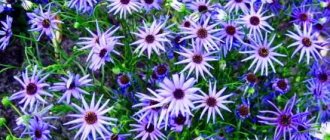Added 02/12/2018 ampels, containers, annuals No comments
Decrease text size Increase text size Text size Print Send by mail
Feruleleaf string (Bidens ferulifolia), and in English-speaking countries - Goldilocks Rocks , or bidens ampelous , as our gardeners most often call this plant, today it is one of the most popular plants for hanging pots, balcony boxes and floor containers. And this is not surprising, since it has all the advantages of an ideal flower for decorating balconies, verandas and terraces.
Bidens ampelous:
- profusely blooming
- Cold-resistant
- Drought-resistant and sun-loving (for the southern regions - a real find!)
- Not noticed in the attacks of malicious pests and intractable diseases
Bidens ferulefolia
So, bidens ampelous, or decorative string, originally from Central America, is grown in our climate as an annual crop, but biologically it is a perennial, and this fact opens up pleasant prospects in terms of preserving its varietal mother plants in the winter. But first things first. Under natural growth conditions, it reaches a height of 60-70 cm, the leaves are openwork, dissected, reminiscent of fennel. The stems are thin, lodging, the flowers are star-shaped, 5-7-petaled golden yellow in color, varietal forms may differ in color nuances - spots, stripes, strokes...
Bidens is grown from seeds at home, but you can buy the most interesting new varieties only in the form of ready-made seedlings in garden pavilions in the last months of spring and early summer. The fashionable bidens flower can be planted in a personal flowerpot, or it can coexist in a mix with partners that are contrasting in color and suitable in habit - blue lobelia, blue petunias, lilac bacopa, purple ampelous viola and other spectacular container flowers.
Varieties and varieties
Bidens belongs to the Astrov family. Sometimes in floriculture circles you can hear such a name for the crop as decorative succession. This plant can be found in the wild in regions of North and South America and in some European countries.
Externally, this plant looks like a tall bush (up to 85 cm in height) with straight and branched stems. The leaves of the decorative series have a jagged edge, and the flowers are shaped like tongues of a rich yellow hue. The inflorescences form peculiar baskets. The fruit of the plant looks like a triangular achene, which has several bristles.
The culture includes more than 249 species. But only annual varieties are used as ornamental plants. Popular Bidens varieties for growing on site are described below.
Golden ball
The bush of the plant is quite voluminous and has many branches. The inflorescences are colored golden or light red. Flowers reach 2.5-4.5 cm in diameter.
Taka Tuka
It belongs to the low-growing varieties (the bushes reach 35-40 cm in height). The flowers are shaped like tongues, which are bright yellow with a light center. Most often, this variety is used to decorate hanging baskets.
Port Royal Double
Externally, the flowers of this variety resemble marigolds. Terry inflorescences are painted in a rich yellow color. The bush is dense.
BiDance Painted Red
A low-growing variety, growing up to 30 cm in height and 45 cm in width. The flowers are shaped like tongues and have a reddish tint and a yellow center. During flowering it emits a strong aroma.
In the last few years, varieties of bidens three-vein have appeared, which have taller stems and spreading branching. Almost all varieties were bred by German or Dutch scientific breeders, so finding planting material in our country will be quite problematic.
Popular bidens varieties
Bidens Taka Tuka
Lemon-yellow reed flowers with white tips are collected in baskets on stems about 35 cm long. Hanging variety, suitable for hanging baskets.
Bidens Port Royal Double
Yellow semi-double flowers on a dense bush look like marigolds from afar.
Bidens Moonlight
It is distinguished by snow-white reed petals with yellowish stamens. Firelight is a two-color variety. The color of the reeds is lilac-pink with white tips and a bunch of long lemon stamens in the center.
Bidens Bee Dance Painted Red
A voluminous plant with a diameter of 40 cm with a charming color - yellow from the center turns into scarlet. A favorite of bees and other pollinating insects. Diploma winner at the German exhibition as the best plant for flower beds and balconies.
Bidens Bee Dance Painted Yellow
The golden petals have a red streak towards the middle.
Planting seeds for seedlings and caring for seedlings
The seedling method of growing bidens is considered the most advantageous. Planting seeds in open ground does not give such quick results and increases the risk that there may be no flowering at all during the planting season. The seedless method is suitable for the southern regions, while the seedling method is suitable for the regions of the middle zone and the north.
On a note:
- Sowing seeds for seedlings should be done about a month before the planned planting of seedlings in open ground. For central regions this may be mid- to late March;
- Fill containers with moist soil. Choose light and loose mixtures. Be sure to drain the planting containers to avoid stagnation of water at the roots. To avoid picking seedlings in the future, you need to distribute the seeds as far apart as possible. The depth of the hole should be no more than 1.5 cm;
- After planting the seeds, moisten the soil and cover the containers with cling film. To prevent the seedlings under the film from starting to rot and mold, open it every day and ventilate the plantings;
- The first noticeable shoots will appear in 14-15 days. From this moment you need to begin carefully monitoring the condition of the soil. It is important to regularly moisten the seedlings, but do not flood them with water. Too wet soil is the first step to the appearance of fungus and rotting of sprouts;
- 9-11 days after the first shoots appear, you need to feed the seedlings with a universal mineral mixture. In order for lateral roots to appear on the stems of the seedlings, as the crop grows, you need to pour a little soil mixture into the containers;
- Before transferring seedlings to open ground, you need to harden them. First, place the seedlings for a while next to an open window, then you can gradually take the boxes outside. At first the walk should take an hour, then two. The maximum time for “walking” seedlings is 24 hours;
- To plant bidens, you need to choose open sunny areas. You can try to plant the bushes in partial shade, but in this case the plant will grow much slower and flowering will be delayed;
- The soil can be of any quality. The culture is not particularly demanding, but in loose and light soil flowering is much more successful. Such bushes look more decorative and healthy. So, if possible, heavy soil should be diluted with a layer of peat or coarse river sand;
- If you plan to grow bidens in pots, you can use a universal flower mixture for planting. As an alternative, you can mix sand, garden soil and humus in proportions 1:1:0.5.
Where to plant bidens ferulefolia
If for a garden or balcony you need a plant that, blooming at the end of spring, will bloom profusely until winter, then you need to select and plant a decorative row or bidence. Currently, there are ampelous forms suitable for flowerpots, flowerpots and containers, tall varieties, up to 1.0 m in height, such plants are suitable for single, border and group plantings in the garden. The homeland of this flower is the south of North America and the countries of the central part of the American continent. There bidens exists in a perennial herbaceous form.
In our climate, the plant is most often grown in an annual or biennial form. Bidens has well-branched bushes. The height of the flower varies from 0.5 to 0.9 meters and during the flowering season it is dotted from top to bottom with yellow baskets of inflorescences up to 4 cm in diameter. Where can you plant this wonderful flower?
Choosing a place for bidens
The plant is extremely unpretentious. A well-lit place with light, sandy or sandy loam soil is ideal for growing it. Although the bushes of the plant develop well on any garden soil and in slight shade.
The plant is very resistant to drought and can tolerate low temperatures. We can say that bidens have no special requirements for watering, temperature, lighting and soil. Given its high tolerance to pests and diseases, the plant belongs to the category of those that are planted and forgotten.
Sowing seeds in open ground
It has already been said that this method of planting crops is suitable only for residents of the southern regions. In this case, flowering will begin very late or will not begin at all in the current season. Seeds are planted in open ground at the end of May or beginning of June. However, if weather conditions still do not allow this, then you need to wait until frost and cold definitely return.
Landing rules:
- To plant bidens, it is recommended to choose a cloudy day or evening. This will help protect the plant from wilting in the early stages of formation;
- Make several shallow holes, in each of which place 3-4 bidens seeds. Even if two of them don’t sprout, don’t worry, the remaining seedlings will form a spherical bush in the future;
- A distance of 40-45 cm should be maintained between each planting, since the plant is lush and spreading. Dense planting can destroy the bush;
- The seeds germinate within two weeks. Caring for seedlings should be the same as caring for young seedlings.
Important! The crop does not tolerate sub-zero temperatures and may die if planted at the wrong time.
Caring for flower crops
Bidens is not particularly demanding in care. But this does not mean that you can not adhere to the rules. So it is important to familiarize yourself with them before planting the plant.
Watering mode and mulching
Due to the structural features of the root system of the shrub, its watering regime may differ slightly from the usual. The rhizome of the plant goes shallow into the soil, but it grows in breadth over a fairly large distance. Moisture evaporates from the soil surface very quickly, so lack of moisture in the root system of bidens is a common phenomenon. You need to water the plant often, but in moderation. It is resistant to drought, but will not tolerate dampness. Immediately after watering, the plant must be mulched to prevent moisture from evaporating too quickly from the surface.
Loosening
Weeding is a mandatory process, since weeds and other third-party plant elements prevent the crop from developing normally and forming inflorescences. It is also necessary to mulch the shrub, since this will not only protect it from moisture evaporation, but also from excessive weed growth. At the same time as removing weeds, you need to loosen the soil around the bush. But do it carefully so as not to touch the roots.
Top dressing
Every two weeks, watering the crop is combined with fertilizer. Phosphorus-potassium mixtures are usually used to help form healthy and strong buds. This feeding will ensure longer and brighter flowering of the plant.
Trimming
To form a beautiful rounded bush, you need to regularly trim the side stems. If this is not done in time, they will stretch out, causing the number of actively flowering buds to decrease and the plant to become less decorative and attractive.
Reproduction methods
You can multiply bidens in two main ways:
- seeds;
- cuttings.
Growing seedlings from seeds is the most convenient and effective way to propagate bidens. You can, of course, plant seeds directly in open ground, but this method is less effective and is not suitable for all regions.
Varietal varieties of the crop are best propagated by cuttings. This method is used only in extreme cases, since it is difficult to preserve the mother bush for cuttings in the spring. However, this method is the only one when it comes to obtaining seedlings that retain all the characteristics of the mother variety. The seed method of propagation in 95% of cases will not retain the original characteristics of the mother variety.
Collecting seeds
The process of collecting bidens seeds is complex. In some cases, it is not only difficult, but also useless. So it is better for novice gardeners and non-professionals to avoid this action.
It is not recommended to collect seeds of varietal species, since they will produce a completely unattractive crop without any signs of the mother variety. If an ordinary plant grows on the site, then the seeds should be collected from it in the autumn, immediately after flowering ends.
To collect seeds, you will need flowers that ripen only at the end of August. Such buds will ripen by the end of September; they can be trimmed and stored in paper bags until spring planting.
Propagation by cuttings
A series of bidens propagation by cuttings, planting and care photo
Bidens in natural conditions is a perennial plant, so you can transplant the bush into a pot at the end of summer and move it to a cool room for the winter, having previously cut it by a third. This is especially true for varietal species.
- In the spring, cut cuttings from this plant and place them in water or wet sand.
- In two weeks the roots will appear.
- Then you can plant them in cups or plant them directly on the flower bed, if conditions permit.
- Cover the planted plants with film or glass for better survival.
- It should be noted that root formation occurs faster if the flower is in the sun and do not forget to water, of course, at this stage watering is required.
Bidens produces abundant self-seeding - next year the plant can appear anywhere. But it’s still better to stock up on seeds. If self-seeding is undesirable, pick off faded buds in a timely manner.
Bidens landscape design
The bright and rich color of bidens flowers will help lift your spirits even on the gloomiest day. You can plant bushes of this plant in any corner of the garden. It will look great in any flower arrangement.
You can also use the culture to decorate pots and baskets, frame garden paths, borders, flower beds and flower beds. Bidens goes well with petunia, verbena, and lobelia.
If you plant bidens next to perennial plants, then you need to select combinations that can decorate the flowerbed continuously throughout the season. Varieties with openwork leaves are well suited for planting next to stone structures such as alpine slides.
Bidens is a low-maintenance crop. It is not susceptible to pest attacks and is resistant to diseases and infections. The bright and lush inflorescences of the decorative series will look impressive in almost any style of landscape design. Since bidens is still an alien plant for our regions, it can be difficult to find planting material.
Video about the rules for sowing Bidens seeds for seedlings and the features of caring for seedlings:
Description of the biden
Botanical characteristics of bidens:
- The height of this plant can range from 20 to 90 centimeters.
- Bidens has the shape of a bush, the diameter of which can range from 30 to 80 centimeters.
- The leaves of this plant are very delicate, they have a dark green color.
- Branching of bidens stems begins at the ground, which ensures the formation of a dense crown.
- The leaves of this plant are densely located on the stems, with the help of which a dense spherical bush is created.
The diameter of the flowers is about three centimeters.
This plant has a large number of flowers, which gives it an openwork appearance. The plant begins to bloom in mid-summer and ends at the first frost. Bidens flowers have a bright yellow color, which attracts the attention of many gardeners and landscape designers.
